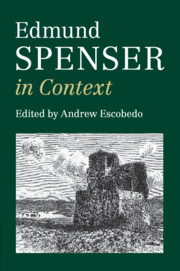We need contexts to help us understand the work of Edmund Spenser. This is true of all imaginative writers, of course, but Spenser presents an unusually extreme case. He is not like Milton, who injects himself into nearly all his work in order to present various aspects of a uniform and assertive personality. Nor is he like Shakespeare, whose works present so much variety that it is arguably impossible to determine which aspects, if any, reflect the author. Spenser certainly presents himself in his poems and prose, sometimes assertively, but with little uniformity. His personae can seem radically different from work to work, and so in the history of reception we have a great variety of Spensers. There is the careerist poet who does not scruple to name-drop and to advertise himself throughout his work. There is the philosophical poet who cites Aristotle and constructs cosmologies worthy of Pico and Bruno. There is the religious poet, militantly anti-papist, but sensitive to the problems and complexities within Protestant theology and ecclesiology. There is the sensuous love poet who celebrates the flesh and binds eros to matrimony. And there is the political poet whose art constantly references national and international affairs, whether to affirm the powers that be or criticize them.
These Spensers are not mutually exclusive, and the chapters in this volume do not operate as if that were the case. But the personae are different enough that we need many lenses to understand them. And understand them we must, since no account of English literary history can do without Spenser. Except for drama, he samples nearly all of the major literary genres of his time. To read Spenser is to read a rich archive of literary forms. He is the greatest poet of what we used to call the Elizabethan Age; excepting Shakespeare, he is arguably the greatest English literary artist of this period. Publically announced early in his career as “this our new Poete,” Spenser helped to establish a highly influential laureate model for English authors. As a colonial administrator and plantation property owner in Ireland, Spenser was involved in some of the most pressing and controversial politics of his time. In few other writers does the pleasure of poetic expression confront the hard edge of political imperative so urgently.
There is no denying, however, that of the major imaginative writers of his time Spenser has become among the most difficult for modern readers to appreciate. Some of the reasons for this are well-known. Spenser’s use of what E.K. terms “olde and obsolete words” raises a significant barrier for engaging his poetry. The allegorical dimension of his work has not made things easier: his “clowdily enwrapped” fictions, as he calls them, have only grown more obscure for some modern readers. Samuel Johnson manages to complain about both of these problems in his censure of The Shepheardes Calender: “Surely, at the same time that a shepherd learns theology, he may gain some acquaintance with his native language.”1 Yet a familiarity with Renaissance satire, allegory, pastoral, church controversy, commonwealth poetry, prosodic experimentation, and early modern literary theory helps us understand why many of Spenser’s readers did not share Johnson’s assessment of Spenser’s shepherds, but rather appeared to take them as learned appropriations of Continental and ancient literary conventions and as intimations of a peculiarly English style and tradition. The chapters of this collection seek to provide that familiarity without denying our distance from Spenser.
This collection, then, has its purpose and scope defined according to the rubric of context. This rubric refers to texts, traditions, events, and practices that were relevant to the production of Spenser’s works. It does not stretch to encompass any possible object that we might compare to Spenser. Thus, Chaucer counts as a context because his poetry impinged on the production of Spenser’s works, but Tennyson does not count as a context, interesting though such a comparison would be. The tripartite division of the collection seeks to distinguish differing orientations toward Spenser’s writing. The first section (Spenser’s Environment) generally concerns itself with structures and institutions to which Spenser responded, the second (Genre and Craft) with the modes in which he wrote, and the third (Influences and Analogues) with what resources he drew upon. The fact that a topic considered as an institution could, with reframing, be likewise considered as a mode of writing amounts not to a shortcoming but rather an opportunity. An elastic notion of context recognizes that the content that readers discover in Spenser’s writing depends considerably upon the lens through which they read. The chapters in this volume, by providing some of these lenses, will ideally inspire readers to fashion new ones for new research on this poet of many faces.

